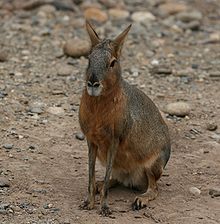Patagonian Mara
| Patagonian mara Temporal range: - Recent |
|
|---|---|
 |
|
| At Temaikèn Zoo, Argentina | |
| Scientific classification | |
| Kingdom: | Animalia |
| Phylum: | Chordata |
| Class: | Mammalia |
| Order: | Rodentia |
| Family: | Caviidae |
| Genus: | Dolichotis |
| Species: | D. patagonum |
| Binomial name | |
|
Dolichotis patagonum (Zimmermann, 1780) |
|
 |
|
| Patagonian mara range | |
The Patagonian mara (Dolichotis patagonum), is a relatively large rodent in the mara genus (Dolichotis). It is also known as the Patagonian cavy, Patagonian hare or dillaby. This herbivorous, somewhat rabbit-like animal is found in open and semi-open habitats in Argentina, including large parts of Patagonia. It is monogamous, but often breeds in warrens that are shared by several pairs.
The Patagonian mara resembles a jackrabbit. It has distinctive long ears and long limbs. Its hind limbs are longer and more muscular than its forelimbs and it has a longer radius than humerus. The feet are compressed, making them hoof-like. The forefeet have 4 digits while the hind feet have 3 digits. Its tail is short, depressed and almost hairless. It has a gray dorsal pelage with a white patch on the rump separated from the dorsal fur by a black area. In addition, the mara has a white underside with a somewhat orange flank and chin. The mara has a head and body length of 69–75 centimetres (27–30 in) with a tail of 4–5 centimetres (1.6–2.0 in). It weighs 8–16 kilograms (18–35 lb). Unlike most other cavids, the anal glands of the mara are between the anus and the base of the tail rather than being anterior to the anus.
The Patagonian mara is found only in Argentina. It ranges from 28ºS to 50ºS. Maras prefer to live in habitats with lots of shrub cover. However they also inhabit overgrazed and barren soils in the Monte Desert biome. In northwestern Argentina the mara primarily inhabits lowland habitats like forest and creosote bush or larrea. Maras prefer sandy and low shrub habitat in Valdes Peninsula. It has adapted well to a cursorial lifestyle on the open plains and steppe, with its long legs, reduced clavicle and well-developed sensory organs making it capable of running and communicating in these open habitats. When running, maras have been compared to deer and antelope. Maras are largely herbivorous. They feed primarily on green vegetation and fruit. In the Monte Desert, monocots make up 70% of its diet while dicots make up 30%. Preferred grass species eaten are those of the genera Chloris, Pappophorum and Trichloris while dicots that are eaten include Atriplex lampa, Lycium and Prosopis.
...
Wikipedia

